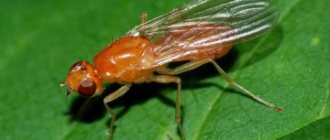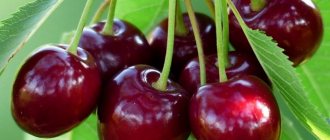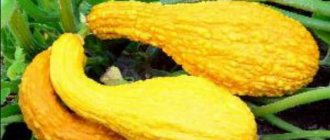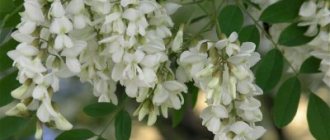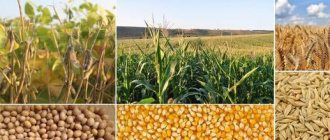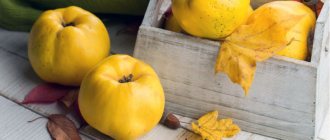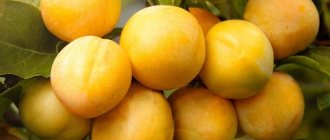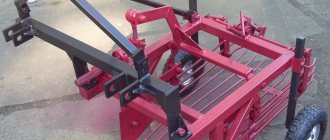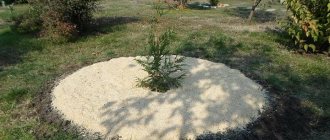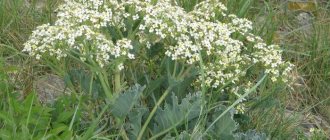Katran is more accommodating than horseradish: how to grow an unusual vegetable on your own plot?
Katran is a light-loving, drought-, cold- and frost-resistant plant.
Prefers soil rich in humus with a thick arable layer, preferably sandy loam or loamy soil.
Our advice:
It does not tolerate close groundwater and reacts poorly to acidic soil (like all plants of the cabbage family, it can get clubroot). In the fall or spring, when digging the soil, I add wood ash (500 g per 1 square meter), and in recent years, having given up digging, I simply scatter the ash and loosen the soil with a Fokin flat cutter to a depth of 3-5 cm.
Features of sowing
Katran seeds are covered with a dense shell, which makes their germination difficult. In spring, seeds can be sown only after 90-100 days of stratification (wet them in water at room temperature for 2-3 hours, then mix 1 part of the seeds and 3 parts of wet river sand and keep until sowing at a temperature of about 0 ° C, avoiding drying out ).
It is easier to sow seeds before winter - from late August to November. I remember when I first received katran seeds (not knowing its characteristics at that time), I sowed them in the spring - I did not see any shoots. And the seeds sown in September sprouted vigorously in the spring.
I sow the seeds to a depth of 2-3 cm with row spacing of 50-60 cm. Shoots from autumn sowing appear in April-May.
Young plants can be damaged by the cruciferous flea beetle; in this case, it is enough to pollinate the seedlings with wood ash in the morning after dew.
Our advice:
When two true leaves appear on the plants, I thin them out, leaving them at a distance of 10-15 cm from each other; when 5-6 leaves form, I increase the distance to 25 cm. By the way, removed plants can be transplanted to another place.
Necessary care
Caring for the katran is usual - systematic loosening of the soil, weeding, and watering if necessary.
In summer, katran leaves can damage cabbage white caterpillars. I usually try to collect them by hand (it’s quite simple), and as a last resort, I spray them with Decis.
When can you harvest?
Katran has a powerful, weakly branched, brittle, juicy root crop.
By the autumn of the first year of cultivation, root crops reach 200-300 g, grow 30-40 cm long and 2-4 cm thick, by the end of the second year it forms root crops weighing up to 1-2 kg (note that horseradish has up to 200 g), 50 cm.
They can be dug up and used for their intended purpose. With the onset of persistent cold weather, the rosette of leaves of the katran tree dies off, and the root crops do not freeze in winter.
In the spring of the second year of cultivation, the katran begins to grow immediately after the soil thaws.
Our advice:
In May-June, flower stalks form on individual plants (very few). If they are not removed, the plant will produce seeds and die without forming a large root crop.
Katran is an excellent honey plant
The flowers are white or pink, there are a lot of them, they have a pleasant honey smell. Flowering katran bushes look like huge balls (diameter up to 1 m).
The amazing honey aroma and beautiful sight of flowering plants can be enjoyed for 2-3 weeks.
The flowering of katran is very long, the seeds ripen at different times. They differ significantly in size; there are very small ones, which, as a rule, do not sprout, and there are also large ones - the size of a pea. I cut off the ripe (brown) stems of the katran in the morning and hang it in the attic for ripening, then thresh it and winnow it, removing small seeds.
Storage and use
When harvesting, I dig deep into the root crops, pull them out of the soil, clear them of leaves and soil, and immediately put them away for storage.
They are perfectly stored in the winter in a basement or cellar, sprinkled with wet sand.
Our advice:
Katran is an excellent substitute for horseradish when canning cucumbers and tomatoes, making various seasonings, salads, sauces, and improves the taste of many cold dishes and snacks.
In the spring, we use the young leaves of the second year of cultivation to prepare various salads, or boil them in salted water and simmer with butter, sprinkled with croutons.
Katran leaves can also be fed to pets.
Useful properties of katran
For medicinal purposes, katran (like horseradish) is used to improve appetite and digestion.
In folk medicine, it is used much more widely - for stomach disorders, as a phytoncidal and antiscorbutic agent, for healing purulent wounds, removing freckles, as a substitute for mustard plasters.
Katran is contraindicated for liver and kidney diseases, stomach ulcers, gastritis and colitis.
Let's sum it up
My katran has been growing in almost the same place for more than 20 years, constantly renewing itself due to self-seeding
During this time, he was not sick with anything, even when I stopped pampering him with attention and transferred him to a Spartan lifestyle
Technology for growing katran from seeds
Katran is a herbaceous perennial plant of the cruciferous family. It has a long stem, one and a half meters long. The leaves are collected in a spreading rosette 60-120 cm high.
The root is cylindrical or cone-shaped, juicy and fleshy, and goes into the ground to a depth of two meters. In one year, the rod grows from 20 to 60 cm in length and from 15 to 50 mm in diameter. Flowering begins in the second year of life.
The fruit of the plant is a pod with one seed. The plant withstands heat and frost.
Reproduces:
- seeds;
- root cuttings.
Growing from seeds
For good germination, seeds require cold stratification. Sowing is best done in October.
The place for sowing is chosen in such a way that there is no groundwater close to the surface of the earth; the area should be well lit by the sun. The soil in the garden is prepared in advance. When digging deeply, add the following to the soil:
- humus;
- potassium salt;
- superphosphate.
The seeds should be at least the size of a pea. Smaller seeds will not sprout. In the prepared soil, make grooves 20-30 mm deep and place seeds in them at a distance of 25 cm from each other.
The interval between rows is at least 60 cm. Winter sowing does not require seed stratification. It takes place in natural conditions. Seed germination occurs at a temperature of +4 degrees. After sowing, the rows are mulched with peat.
After the sprouts appear, mulching is repeated.
If sowing is carried out in the spring, then the seeds undergo stratification for 95 days before sowing.
The seeds are soaked, mixed with coarse sand, poured into a container and stored in the refrigerator until sowing at a temperature of 0-4 degrees.
After this time, the container with the seeds is removed from the refrigerator and placed on a well-lit windowsill. For good growth and development, the room temperature should be + 22 degrees.
Seedlings are transplanted to a permanent place of growth at the age of six weeks, when each of them has 5-6 true leaves. Seedlings are planted with an interval of 40 cm between plants and 60 cm between rows. In the first year of growth, only a rosette of leaves is formed in the plants. In the second year, the green mass grows much faster.
Care
Caring for the plant is not particularly difficult and consists of the following activities:
- Thinning is carried out in the case of sowing in the ground before winter. When seedlings grow to 8 cm, weak and poorly developed plants are removed, leaving an interval of 40 cm between seedlings.
- From the moment the seedlings reach a height of 20 cm, they begin to loosen the rows and remove weeds.
- In the phase of the appearance of the first leaves, preventive treatment against pests is carried out. Watering during this period is carried out as needed.
- In May, watering is performed more frequently and water consumption is increased. On average per 1 sq. meter water consumption should be 30 liters.
- The first feeding of the plant is carried out during thinning. To do this, for 1 sq. meter add 5 grams of ammonium nitrate. The second feeding is carried out when the seedlings have five true leaves. During this period, per 1 sq. meter contribute:
- ammonium nitrate—7 grams;
- potassium salt - 10-15 grams.
Reproduction
In addition to the seed method, steppe horseradish is also propagated using root cuttings. They are cut in the fall, after harvesting from lateral roots at least fifteen cm long.
All buds are removed from the cuttings, leaving only the top one, and the bottom and top cuts are marked. Then the cuttings are collected into bunches and stored until spring in a refrigerator at a temperature of 0 degrees.
Planted in the spring in a permanent place of growth, buried in the soil at an angle and tightly pressing the soil around.
How to increase productivity
In order for the productivity of katran to become higher, it is necessary to cut off the head of the plant by 3 cm at the age of two. After cutting, the peduncle will stop developing, and the root crop will rapidly increase in size.
Types of katran
In our region, the most common types are:
- Tatar;
- steppe;
- pinnate;
- cordate;
- Oriental.
Tatar katran
This type of katran is not picky about soils. Grows in mountains, steppes, and on soils containing fine gravel. This type is common:
- in Siberia;
- in the Caucasus;
- In Crimea;
- In Central Russia.
The height of the shoots reaches 100 cm, the leaves have a bluish-green color, the flowers are white, collected in inflorescences. The root has the greatest value. Its length can reach 50 cm, diameter up to 7 cm, weight - 600 grams.
All parts of the plant are used in cooking. The taste of katran is very pungent, so you need to add it when preparing dishes with caution. The oil squeezed from the seeds has a bitter taste. The young roots of the plant are pickled and salted for the winter. Tatar katran is rich in vitamin C in all its parts.
Katran seaside
This variety has three types of leaves:
- Basal - large, petiolate;
- stem - medium size;
- apical - the smallest.
The inflorescences are white with a rich aroma.
Katran cordifolia
The height of the shoots is 1.5 meters, with heart-shaped, large leaves. Young leaves have a purple tint. After some time, the leaves become green. Flowering period: June-July. The flowers are white, used to decorate white salads.
Harvest
In early spring, leaves and young shoots up to 12 cm long are collected. In summer, flower stems with buds 10-15 cm long are collected.
Root crops are harvested in the second or third year of life at the end of September. Before harvesting, cut off all leaves. At this point, they reach a length of 55-60 cm and a diameter of 6-8 cm. To avoid damaging the plant when digging them out, dig around the plant with a pitchfork or staples.
The dug up roots are sprinkled with damp sand and stored in the basement at a temperature of 0 degrees.
Application
Young leaves are eaten like spinach, raw or boiled. The shoots are cooked like asparagus and the flower stems are cooked like broccoli.
Root vegetables are used in grated form to prepare table horseradish, as well as for canning vegetables. The roots taste like horseradish, only less spicy and more juicy. Root vegetables can also be boiled or baked.
Useful properties and contraindications
Steppe horseradish has long been used by healers:
- for healing wounds and cuts;
- a decoction of the roots is used as a general tonic;
- fresh consumption protects against scurvy;
- to improve the functioning of the digestive system and increase appetite;
- to remove freckles.
Contraindicated for use if you have:
- kidney;
- liver;
- stomach;
- duodenal ulcer.
Considering all the characteristics and positive reviews from gardeners, katran may well be an alternative to horseradish, not inferior in taste and benefits to the body.
Source: https://ogorodnik.net/tehnologija-vyrashhivanija-katrana-iz-semjan/
How to grow
To grow katran in your summer cottage, it is important to create favorable conditions for the plant. They note the undemandingness of katran to the soil
Prefers loose, non-acidic sandy loam or light loamy soil. Heavy soil is not suitable for planting: seed material takes a long time to germinate and poorly, acidic soil will provide the vegetable with poor growth and disease
They note that katran is undemanding to the soil. Prefers loose, non-acidic sandy loam or light loamy soil. Heavy soil is not suitable for planting: seed material takes a long time to germinate and poorly, acidic soil will provide the vegetable with poor growth and disease.
The planting site for the vegetable is chosen to be open, illuminated by the sun. The plant does not tolerate darkening.
Katran grows and develops at air temperatures of +19…+25 °C. Seed germination occurs at +4 °C. The plant is winter-hardy: the seedlings tolerate frosts down to -6 °C.
Optimal predecessors for vegetables:
- potatoes and pumpkin;
- beans and cucumbers;
- peas and eggplants.
How to grow Katran horseradish on your own plot
Horseradish Katran belongs to the group of perennial plants, the Cabbage family. The culture differs not only in appearance from ordinary horseradish, but also in taste. The plant is not picky, but in order for it to decorate the area for a long time, you need to follow simple rules.
Horseradish Katran: description of the appearance of the plant
Katran or Katran seaside, as it is also called, is a herbaceous plant. It grows in the form of a bush, the height of which reaches almost 70 cm. The root system has a cylindrical shape. The main and only root grows up to 10 cm in diameter. The pulp is white, dense.
In nature, there are many different varieties of horseradish Katran, but the most popular are:
- path-like;
- Oriental;
- steppe or Tatar;
- nautical;
- Crimean.
The horseradish bush forms rosettes that are slightly raised upward. White flowers. They are all the same size. When open, the diameter of the buds does not exceed 1 cm. At the end of flowering, fruits in the form of elongated pods are formed in their place.
The homeland of this amazing plant is the coasts of the Black Sea, Azov Sea and the Atlantic. It can be seen less often in the lands of the Caucasus.
Katran: growing from seeds
Even a schoolchild can plant and grow this type of horseradish on the plot. All this is not due to the fastidiousness of culture. The main thing is to correctly prepare the planting material and have information about the correct planting of grains.
Stratification of katran seeds at home
This is an important point when propagating Katrana by seeds:
- Initially, you will need to soak the grains in clean water, the temperature of which is from +180 C to +200 C. You can also use a solution of potassium permanganate (1%).
- After two hours, transfer the planting material to a cloth, and after a few minutes mix it with fine-grained, wet sand.
- Keep the resulting mixture at zero air temperature for 3 to 4 months. An excellent option is the bottom shelf of the refrigerator or basement.
Choosing a landing site
Planting seeds is best done on sandy, loamy soils. The soil should also have minimal acidity levels. In heavy substrates, grains germinate very poorly, and adult plants can lose their appearance, which negatively affects the nutritional properties of the root.
The optimal location is areas where groundwater flows very close.
Rules for sowing grains
Before you begin the procedure, you need to prepare a place for planting. The first thing you need to do is dig up the bed. Then add 3 to 4 kg of humus per 1 m2. If it is not possible to use organic matter, then you can replace it with purchased fertilizers based on phosphorus or potassium. An excellent option is “Kemir-Super”, “Azofoska”.
The grains need to be sown to a depth of no more than 3 cm. The optimal width between rows is considered to be about 65 cm. Planting is carried out using the strip method. In each of them you need to form 3 lines. They should be located at a distance of 35 cm. The width between the tapes themselves should be within 65 cm.
After planting, the area is mulched. For this you can use peat or humus. Mulch is especially important if sowing is carried out not in spring, but in autumn. The rows are re-covered with humus immediately after the first shoots appear.
Irrigation
The first shoots must be thoroughly watered with settled water, and after two pairs of leaves appear, they need to be thinned out. The optimal distance between specimens is 30 cm.
During the dry season, plants are irrigated frequently. Starting from May, watering is increased. If the air temperature remains high outside for a long time and there is no rain, then irrigation is carried out at least twice a week.
Loosening the soil
This procedure is carried out often, especially if the plants are still small. You don’t need to loosen the soil very deeply, otherwise you can damage the root system.
Horseradish feeding Katran
The first batch of fertilizer is applied at the time when thinning is carried out. Saltpeter is used for this. It is recommended to apply up to 10 g of the drug per 1 m2. The second feeding is carried out after the appearance of 5 leaves with 15 g of potassium salt and 7 g of saltpeter.
If possible, it is best to fertilize Katran with liquid preparations.
Increased yield
In order for the roots to be as thick and long as possible, it is necessary to cut off the head of the plant by 3 cm in the second year. After this, the crop will not spend all its energy on the development of the peduncle, but will devote it to the formation of the root crop.
Kinds
Katran, judging by the species name, is a plant of the coasts of the Baltic and Black Seas, as well as the Atlantic. Not often, but it is also found in the Caucasus. In total, there are approximately 30 species of katran, all of them forage. Two types are mainly used for food – sea and Tatar.
Tatar katran is especially popular. It also has the following names: crambe, eastern, steppe. The homeland of this species of wild plant is the Crimea, where it was first domesticated by humans.
Approximately 20 species of katran grow in the countries of the former CIS. Some of them (Tatar, Primorsky, Oriental and Twig-shaped) after being introduced into cultivation began to be used as oilseeds, fodder, vegetables, melliferous and starchy plants.
Horseradish Katran: description of the appearance of the plant
Katran or Katran seaside, as it is also called, is a herbaceous plant. It grows in the form of a bush, the height of which reaches almost 70 cm. The root system has a cylindrical shape. The main and only root grows up to 10 cm in diameter. The pulp is white, dense.
In nature, there are many different varieties of horseradish Katran, but the most popular are:
- path-like;
- Oriental;
- steppe or Tatar;
- nautical;
- Crimean.
The horseradish bush forms rosettes that are slightly raised upward. White flowers. They are all the same size. When open, the diameter of the buds does not exceed 1 cm. At the end of flowering, fruits in the form of elongated pods are formed in their place.
The homeland of this amazing plant is the coasts of the Black Sea, Azov Sea and the Atlantic. It can be seen less often in the lands of the Caucasus.
On this topic:
Description
Katran (more precisely, seaside Katran) is a herbaceous plant with an average height of 50 to 70 cm, having a thick (7-10 cm) cylindrical root with white pulp. Raised rosettes of large leaves are formed. Small, numerous white flowers up to 1 cm in diameter. The katran fruit has the shape of a pod.
The large, thick and juicy root has virtually no branches. Already in the second year of growth, its diameter is 2.5 cm and its weight is 0.5 kg. By the third year, its weight reaches 3.5 kilograms. The large leaves of the plant resemble cabbage leaves.
Flowering begins after 2 years of plant growth. Flowers are located on long branching stems up to one and a half meters high. They have a very pleasant honey aroma, so bees are partial to them. The pod-shaped fruits have a single seed, also similar to cabbage.
Proper care of horseradish Katran
After sowing the seeds, the bed is left alone until the first shoots appear. Then comes the time of painstaking work.
The first shoots must be thoroughly watered with settled water, and after two pairs of leaves appear, they need to be thinned out. The optimal distance between specimens is 30 cm.
During the dry season, plants are irrigated frequently. Starting from May, watering is increased. If the air temperature remains high outside for a long time and there is no rain, then irrigation is carried out at least twice a week.
Loosening the soil
This procedure is carried out often, especially if the plants are still small. You don’t need to loosen the soil very deeply, otherwise you can damage the root system.
Horseradish feeding Katran
The first batch of fertilizer is applied at the time when thinning is carried out. Saltpeter is used for this. It is recommended to apply up to 10 g of the drug per 1 m2. The second feeding is carried out after the appearance of 5 leaves with 15 g of potassium salt and 7 g of saltpeter.
If possible, it is best to fertilize Katran with liquid preparations.
Increased yield
In order for the roots to be as thick and long as possible, it is necessary to cut off the head of the plant by 3 cm in the second year. After this, the crop will not spend all its energy on the development of the peduncle, but will devote it to the formation of the root crop.
Several recipes
- A very aromatic and tasty dish is made from the following ingredients: 0.5 kg of pork meat, 0.5 kg of potatoes, 1 onion. All this is stewed and closer to complete readiness, it is filled with half a glass of grated katran root.
- You can make a sauce from katran and apples. One grated apple is mixed with half a glass of grated katran. Add vegetable oil, vinegar and 2 tablespoons of sour cream. A wonderful dish is ready.
- The stems and leaves of katran are boiled in salted water, seasoned with oil and rolled in breadcrumbs. It turns out to be a good nutritious and healthy dish.
Description of the horseradish katran plant: what it looks like - in the photo
Starting the description of katran, it is worth noting that this vegetable is little known to residents of the black earth region. It is found wild in the foothills of the Crimea and the Caucasus. However, this unpretentious plant does not differ in taste from horseradish and is successfully cultivated in different soil and climatic zones. Grows well in the Urals and Siberia. Residents of these regions know exactly what katran looks like and where to find it in the nearest forest or in their garden.
Horseradish Katran belongs to the Cruciferous family. In Crimea it is called “Crimean horseradish”. It has a cylindrical, straight, slightly branched, fleshy root that grows very quickly. On rich chernozems it goes into the soil to a depth of 60 cm without branching, then it is overgrown with lateral rhizomes and penetrates to a depth of 2.8 m or more.
Katran is considered a long-lived plant, which in the first year of its life produces a rosette of large, faded green, rough leaves growing up to 40 cm in length, and in the second year a large loose inflorescence of numerous, small snow-white flowers appears and a powerful, up to two meters, is formed. the root through which the plant receives moisture from the soil. What is important for this plant is dry, nutritious, but not acidic soil and a warm, sunny, wind-free place. It reproduces by shoots and seeds after preliminary winter stratification. The plant reaches its peak only in the third year of life.
Look at the katran plant in the photo, where its various types and varieties are offered for evaluation:
Varieties of katran
Let's look at some varieties of katran suitable for growing in cultivation on a personal plot.
Crambe maritima - seaside katran.
Cruciferae - cruciferous.
An ornamental perennial plant reaching 50–60 cm in height and the same width. The leaves and stems form a bush on a strong, woody rhizome. Young leaves are deep purple in color, later they acquire blue-green hues and become wavy at the edges. White-purple flowers are collected in large inflorescences-umbrellas.
Landing place. Open area. Sunny locations with nutritious, slightly sandy, moderately moist soil with good drainage. Does not tolerate acidic and heavy (clayey) soils. The plant has a long root, so deep soils are preferable for it.
Harvesting. Young leaves and shoots up to 12 cm long are collected in early spring. Productivity reaches from 0.5 to 2 kg per 1 m2. In summer - flower stems 10–15 cm long with unopened buds.
Eating. Young leaves are eaten fresh or cooked, like spinach. Young shoots can be cooked like asparagus. We assume that they have a nutty flavor with a slight bitterness. Young flower stems can be cooked like broccoli.
Reproduction. Propagation by division of rhizomes or direct sowing. Etiolation of shoots grown from root cuttings is possible from the second year. And plants planted with seeds are etiolated from the third year of the growing season. Seeds are planted in spring in deep sandy soil with good drainage, the first harvest is harvested after 2 years. The total fruiting time is 8–10 years.
Decorative value. Beautiful large leaves with a bluish tint, wavy along the edges.
Origin. Coasts of Western and Northern Europe.
In England there is a tradition of etiolation of young shoots in special clay pots immediately after the leaves bloom. Also, for etiolation, young shoots can be sprinkled, like asparagus, with a 20–30 cm layer of soil, foliage, etc., or wrapped in film. Crambe cordifolia (heart-leafed katran) is a large free-standing perennial plant 180 cm high, with leaves the size of a car wheel and huge white panicle inflorescences. Grows in sunny places with nutritious soil and good drainage. We assume that in etiolated form it is suitable for vegetable dishes.
Application
Katran is used in folk medicine as a phytoncidal agent. He is a beautiful flower stalk. The plant is also used to improve appetite. This is an excellent antibiotic, as well as an antiscorbutic agent, used both for stomach disorders and as mustard plasters.
The roots are fleshy and have been eaten both raw and canned since ancient times. They are added to salads and sauces, and used for pickling tomatoes and cucumbers. Spring young leaves and young shoots are used in cooking much like cauliflower.
The young shoots of the katran plant taste like radishes. It should be noted that its roots can be consumed both boiled and baked.
Description of the horseradish katran plant: what it looks like - in the photo
Starting the description of katran, it is worth noting that this vegetable is little known to residents of the black earth region. It is found wild in the foothills of the Crimea and the Caucasus. However, this unpretentious plant does not differ in taste from horseradish and is successfully cultivated in different soil and climatic zones. Grows well in the Urals and Siberia. Residents of these regions know exactly what katran looks like and where to find it in the nearest forest or in their garden.
Horseradish Katran belongs to the Cruciferous family. In Crimea it is called “Crimean horseradish”. It has a cylindrical, straight, slightly branched, fleshy root that grows very quickly. On rich chernozems it goes into the soil to a depth of 60 cm without branching, then it is overgrown with lateral rhizomes and penetrates to a depth of 2.8 m or more.
Katran is considered a long-lived plant, which in the first year of its life produces a rosette of large, faded green, rough leaves growing up to 40 cm in length, and in the second year a large loose inflorescence of numerous, small snow-white flowers appears and a powerful, up to two meters, is formed. the root through which the plant receives moisture from the soil. What is important for this plant is dry, nutritious, but not acidic soil and a warm, sunny, wind-free place. It reproduces by shoots and seeds after preliminary winter stratification. The plant reaches its peak only in the third year of life.
Look at the katran plant in the photo, where its various types and varieties are offered for evaluation:
Varieties of katran
Let's look at some varieties of katran suitable for growing in cultivation on a personal plot.
Crambe maritima - seaside katran.
Cruciferae - cruciferous.
An ornamental perennial plant reaching 50–60 cm in height and the same width. The leaves and stems form a bush on a strong, woody rhizome. Young leaves are deep purple in color, later they acquire blue-green hues and become wavy at the edges. White-purple flowers are collected in large inflorescences-umbrellas.
Landing place. Open area. Sunny locations with nutritious, slightly sandy, moderately moist soil with good drainage. Does not tolerate acidic and heavy (clayey) soils. The plant has a long root, so deep soils are preferable for it.
Harvesting. Young leaves and shoots up to 12 cm long are collected in early spring. Productivity reaches from 0.5 to 2 kg per 1 m2. In summer - flower stems 10–15 cm long with unopened buds.
Eating. Young leaves are eaten fresh or cooked, like spinach. Young shoots can be cooked like asparagus. We assume that they have a nutty flavor with a slight bitterness. Young flower stems can be cooked like broccoli.
Reproduction. Propagation by division of rhizomes or direct sowing. Etiolation of shoots grown from root cuttings is possible from the second year. And plants planted with seeds are etiolated from the third year of the growing season. Seeds are planted in spring in deep sandy soil with good drainage, the first harvest is harvested after 2 years. The total fruiting time is 8–10 years.
Decorative value. Beautiful large leaves with a bluish tint, wavy along the edges.
Origin. Coasts of Western and Northern Europe.
In England there is a tradition of etiolation of young shoots in special clay pots immediately after the leaves bloom. Also, for etiolation, young shoots can be sprinkled, like asparagus, with a 20–30 cm layer of soil, foliage, etc., or wrapped in film. Crambe cordifolia (heart-leafed katran) is a large free-standing perennial plant 180 cm high, with leaves the size of a car wheel and huge white panicle inflorescences. Grows in sunny places with nutritious soil and good drainage. We assume that in etiolated form it is suitable for vegetable dishes.
general information
The katran plant can well be called an analogue of horseradish. But in comparison with the second one, it is more convenient to grow, and not only that. This is especially true for large volumes of production of this plant.
In addition, katran is more productive and tastier, and its main feature is that it practically does not clog the site. Not only the roots of the plant are eaten, but also young leaves and shoots (similar to asparagus). It is also important that katran is widely used by landscape designers as an ornamental plant in flower arrangements.
The katran plant is rich in various nutrients, has smooth-looking rhizomes and can be grown from seeds. And caring for it is much easier than horseradish.
Katran is a perennial plant from the cabbage family (like horseradish). It grows well on light fertile soils, is not picky about climatic conditions - it tolerates both cold and drought well, and is not very demanding on light. In this regard, any area is suitable for planting katran, even in the very corner or in the shade near the fence. In all respects, the katran plant is unpretentious.
Secrets of successful cultivation
This plant can be planted in the last ten days of March or early April. The plant has good resistance to sudden temperature changes and cold weather, so after planting the risk of freezing is minimal.
Seat
This crop loves to grow on fertile soil. Horseradish can be planted on black soil, sandy loam or loam. The best predecessors are barley, wheat, oats, and legumes.
Before planting the plant, it is necessary to increase the nutritional value of the soil. Fertilizers are applied in the fall at the rate of 2 buckets of humus, the same amount of peat and a bucket of sand per 1 square meter. m. Then the soil is dug up and leveled. With the arrival of spring, additional mineral fertilizers are applied - 30 g of superphosphate and potassium salt per 1 square meter. m.
The places where horseradish grows are usually very sunny: areas near fences, gazebos, arches. Horseradish can be grown in the garden, only away from other useful crops. This herb spreads quickly and can inhibit the growth of other vegetation in the area.
Cuttings
Material for growing garden horseradish is harvested in the fall. The cuttings are dug up, placed in dry sand or sawdust, and stored in any cool place until spring. Some prepare cuttings in the spring - cut them into segments until the buds awaken.
Two weeks before the planned planting, the cuttings are removed from the cellar, covered with a well-moistened cloth and kept warm so that they sprout.
Before planting, thick side stems up to 25 cm long are separated from the root using a sharp knife. If they are too long, they are divided into segments - the upper cut is made even, and the lower one is inclined.
Spring planting technique
We plant horseradish at a distance of 45 cm from each other, maintaining a distance in the row of about 70 cm. The optimal number of cuttings per 1 square. m. - 4-6 pcs.
To obtain a high-quality and beautiful harvest of root crops, it is necessary to clear the cuttings from the bark with buds in the middle, and leave the top and bottom intact. Young leaves will form from the top, and many young roots will appear below.
To obtain planting material, the bark with buds in the middle is left to obtain a branched root crop with numerous cuttings.
For horseradish, planting in open ground has some subtleties - the cuttings are planted at an angle so that the upper part is 5 cm in the soil and the lower part is 10 cm.
How to grow horseradish from roots is one of the most popular questions among gardeners. For planting, use roots at least 8 cm long and about 2.5 cm in diameter. They are placed in dug grooves in a horizontal position so as not to damage the buds. Then they are sprinkled with earth, the soil is compacted, and watered abundantly with warm and settled water. For 1 sq. m. use 10 liters of water.
Before winter
For horseradish, late planting is carried out in the second half of October. An area where potatoes or tomatoes previously grew is suitable. The area is cleared of weeds and vegetation residues and dug up. Level and sprinkle with humus - a bucket for 1 square meter. m. Preparations can be planted 2 weeks after preparing the soil. Growing horseradish in the country before winter follows the same principle as in spring.
Storage and Freezing of Katran
Katran leaves do not store well, but you can store them in the refrigerator for up to 2 weeks. As mentioned above, just leave it in the ground if you want to keep the katran throughout the winter. It should be good in the ground for at least two months after the first frost (longer in warmer climates).
To store frozen, do the following: wash the leaves, remove the stems, blanch for two minutes (less for younger leaves), then cool, strain, bag and place in the freezer.
Katran seeds remain viable for about 4 years.
Preserving the Katrana harvest
- Storage temperature : 0 to 4 degrees Celsius)
- Humidity : 90 to 95% relative humidity
- Shelf life (thawed under the above conditions) : about 2 weeks
- Shelf life (frozen) : About 10 months
- Seed shelf life
: About 4 years
How to grow Katran horseradish on your own plot
Horseradish Katran: description of the appearance of the plant
In nature, there are many different varieties of horseradish Katran, but the most popular are:
- path-like;
- Oriental;
- steppe or Tatar;
- nautical;
- Crimean.
The homeland of this amazing plant is the coasts of the Black Sea, Azov Sea and the Atlantic. It can be seen less often in the lands of the Caucasus.
Katran: growing from seeds
Stratification of katran seeds at home
This is an important point when propagating Katrana by seeds:
- Initially, you will need to soak the grains in clean water, the temperature of which is from +18 0 C to +20 0 C. You can also use a solution of potassium permanganate (1%).
- After two hours, transfer the planting material to a cloth, and after a few minutes mix it with fine-grained, wet sand.
- Keep the resulting mixture at zero air temperature for 3 to 4 months. An excellent option is the bottom shelf of the refrigerator or basement.
Choosing a landing site
Planting seeds is best done on sandy, loamy soils. The soil should also have minimal acidity levels. In heavy substrates, grains germinate very poorly, and adult plants can lose their appearance, which negatively affects the nutritional properties of the root.
Rules for sowing grains
The grains need to be sown to a depth of no more than 3 cm. The optimal width between rows is considered to be about 65 cm. Planting is carried out using the strip method. In each of them you need to form 3 lines. They should be located at a distance of 35 cm. The width between the tapes themselves should be within 65 cm.
After planting, the area is mulched. For this you can use peat or humus. Mulch is especially important if sowing is carried out not in spring, but in autumn. The rows are re-covered with humus immediately after the first shoots appear.
Proper care of horseradish Katran
After sowing the seeds, the bed is left alone until the first shoots appear. Then comes the time of painstaking work.
Irrigation
During the dry season, plants are irrigated frequently. Starting from May, watering is increased. If the air temperature remains high outside for a long time and there is no rain, then irrigation is carried out at least twice a week.
Loosening the soil
This procedure is carried out often, especially if the plants are still small. You don’t need to loosen the soil very deeply, otherwise you can damage the root system.
Increased yield
In order for the roots to be as thick and long as possible, it is necessary to cut off the head of the plant by 3 cm in the second year. After this, the crop will not spend all its energy on the development of the peduncle, but will devote it to the formation of the root crop.
Harvesting horseradish Katran
With proper care, you can dig up to 1 kg of crop from 1 m2. To ensure that the product lasts as long as possible, it is recommended to place the roots in damp sand. The container with horseradish is kept at low air temperatures. A cellar or basement is well suited for this. It is in these places that humidity levels are within 85%.
Green mass and root vegetables are used both in medicine and in cooking. Young leaves are added raw to salads, and the shoots are boiled or steamed, like asparagus. A seasoning, horseradish, is made from the roots and added to preserves. Some people bake root vegetables in the oven. Thanks to the high air temperature, they become very soft and juicy. Such vegetables are less spicy, which makes it possible for people with stomach diseases to consume them.
Horseradish Katran is a unique plant that will become a real find in the kitchen. When grown correctly, the root vegetable will delight everyone with its not only spicy taste, but also saturate the body with all the necessary vitamins and microelements.
Where is Katran used?
Both the underground part of the katran and the above-ground part (young leaves with petioles) can be used for food. Root vegetables taste similar to horseradish, but are juicier and healthier (richer in chemical composition). They are boiled, baked, added to salads and vegetables when canning. The seasoning made from crushed katran root vegetables is as spicy and fragrant as that made from horseradish. Young leaves with petioles can be boiled, then rolled in breading mixture and fried in oil.
Katran is also used for medicinal purposes. It stimulates intestinal function, improves appetite, and can be used as an additional remedy in the treatment of gums. A decoction of katran rhizomes is a good general tonic.
Katrana root crops


